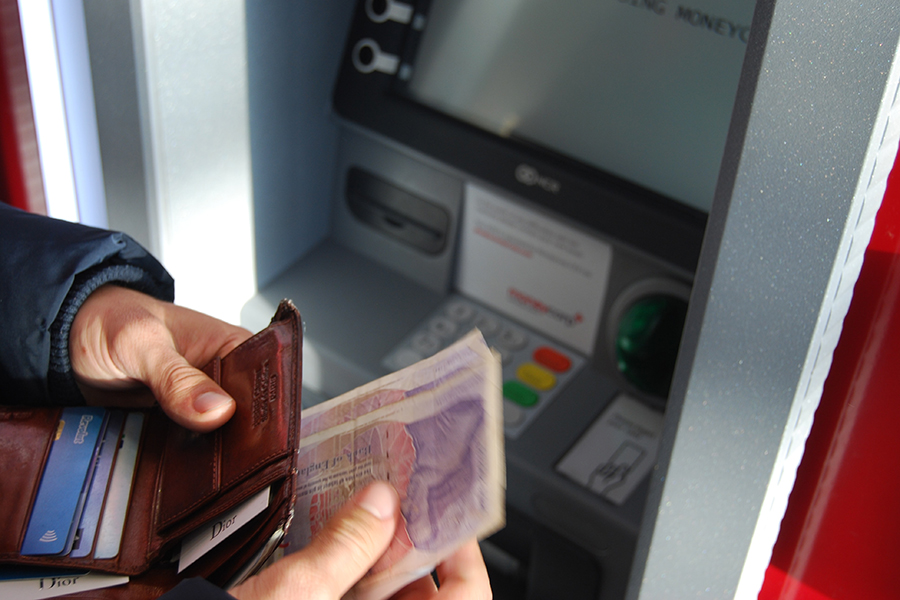
By Dr Ann-Christine Frandsen, Reader in Accounting
Birmingham Business School, University of Birmingham.
The use of a cash machine is not just a matter of finding one it is also about having access to a bank account. In 2015 the Financial Inclusion Commission stated that almost 2 million adults in the UK had no bank account. It is a major social injustice no doubt. But serious consequences lurk within a fully cashless economy, from cash black markets to major power failures, denial-of-service attacks and wars as serious threats to the payments system as we know it.
All these dramatic scenarios can be seen as a manifestation of bank architecture, and of the barriers, both material and immaterial, which have been key features of that architecture since banking first developed in Mesopotamian temple-storehouses. Where the material ones began as solid walls and doors, the immaterial began as the accounts recording in ‘money of account’ terms the deposit, loan, debt and credit positions of both banks and customers. These two sets of barriers have therefore also always operationalised thresholds defining who and what is inside and outside the bank. And access to cash is only for insiders. So focussing on these barriers, and how they also act as joint thresholds, becomes a way of making visible how there is always an essential interplay between bank architecture in this broad sense and the money forms (money of account, cash, electronic money) that reside within and beyond the physical bank’s walls.
In Sweden, you cannot make a cash deposit at a bank branch anymore. Instead, you must use specially enabled ‘cash deposit machines’ which may be far from your home. Meanwhile, the bank branch’s architecture corresponds to this new e-money set-up. The space where bank ‘transactions’ are discussed is over a casual table, like a café without the coffee. The e-money becomes ‘present’ through an interplay of the screen, chat, and keystrokes—all so long as both sets of barriers remain thresholds. And the same applies now beyond the material bank barriers. The e-money can be ‘materialised’ at home, in bed perhaps, or in the supermarket as you buy your milk and bread, or anywhere with ‘contactless’ payment—so long as you are inside the barrier-thresholds. So this is just another form of bank architecture. But it is one that has emerged only since the 1950s, when there began to be major architectural changes in what it means to be a bank, in both its material and immaterial forms, and its locations. Money has increasingly migrated beyond coins and notes, cash and cheques, just as the bank has migrated from stone to glass, from barriers separating staff from customers to open space conversations. No longer are notes counted by a speedy finger covered in a rubber thimblett. No longer is there an automatic welcome for small traders wishing to pay in the day’s cash takings. The bank’s barrier-thresholds embody an open architectural presence, of transparence within the branch, and global online availability beyond it: and the many new money forms they offer are globally and immediately available, so long as you are inside the barriers, and the systems are up and running.
The e-money bank architecture constructs its own barrier-thresholds. But as e-money travels so fast and endlessly to almost every corner of the world (and back), such barriers need new robustness to match that of the old ones formerly in play. With worldwide internet and satellite networks as the means of monetary transmission, the links to wealth’s physical manifestation diminish. Links to older barrier-thresholds need to be re-established. The customer needs reassuring that all this immaterial e-money is still safe since we know how fragile, as well as convenient, the e-world can be, and how serious the consequences when it fails. But additionally, who is inside or outside changes as the barrier-thresholds change. In “open access”, competitor banks can now review a customer’s accounts and pitch their services to them, thereby making you the customer the “insider” and your current bank the “outsider”. E-money innovations such as cryptocurrencies and their ‘manufacturers’ remove retail and even central banks from ‘insider’ status, thus not just moving the barriers of banking but who gets to set those barriers: and where will the barrier-thresholds move next. And so just who will then be on the inside, and who on the outside?
The blog is based on the article: Frandsen and McGoun (2020) The Barriers of Banking. Architecture & Finance, The European Association for Banking and Financial History Bulletin, Vol. 3, pp.24-31.
The views and opinions expressed in this article are those of the author and do not necessarily reflect the official policy or position of the University of Birmingham.
